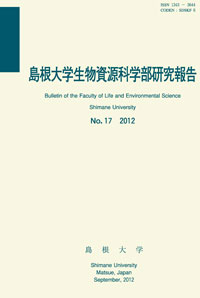島根大学生物資源科学部
ISSN:2435-0885(オンライン)
ISSN:1343-3644(冊子体)
なお、冊子体の刊行は23巻まで
ISSN:1343-3644(冊子体)
なお、冊子体の刊行は23巻まで

ダウンロード数 : ? 件
この文献の参照には次のURLをご利用ください : https://ir.lib.shimane-u.ac.jp/3518
島根大学生物資源科学部研究報告 4
1999-12-20 発行
流域の部分的開発及び造成畑地の特性を考慮した集中定数型流出モデル
A Lumped Parametric Runoff Model considered A Partially Development of Basin and Characteristics of Reclaimed Upland Field
ファイル
内容記述(抄録等)
The study purposes to develop a technique of runoff analysis evaluating the hydrological effects of partially development by land reclamation in a hilly area and considering the characteristics of soil moisture retentionin the surface layer of a reclaimed upland field. Three types of runoff modelare offered and these model are identified by using the observed hydrograph in the experimental basin. The outline is as follows:
(1) The first model is modified from the Long- and Short- Terms Runoff Model(LST-II model), which is called as a modified LST-II model. The land use effect caused by partial land reclamation in a hilly watershed is included in the model, i.e., the upper zone of first tank in the LST-II model is divided into two parts in the ratio of the area composed by a reclaimed upland field and a hilly area.
(2) The second one is a modification of the lumped kinematic wave storage model(KiWS model) which is originally combined the kinematic wave runoff model and the LST-II model.
(3) The third one is another modification of LST-II model, which considers retension characteristics of rainwater as soil moisture equivaient to field capacity in the surface layer of a reclaimed upland field.
(4) Runoff calculation system is constructed by using UNIX workstation, to carry out a series of anlysis; and output of hydrographs.
(5) By applying the modified Standarized Powell method, these proposed runoff models are identified. And it is shown that the runoff analysis using the modified LST-II model and the modified lumped KiWS model improve slightly the reproducibility of the observed hydrograph.
自然丘陵地流域の流出特性を吟味するための流出解析法については,ほぼ実用的レベルで満足すべき流出モデルが確立されているが,農地造成など流域内の部分的開発に伴って,流出モデル定数がどのように変化するかについての実用的手法については,なお検討の余地があると思われる.本報告では,まず集中定数型流出モデルを応用して,流域内の部分的開発の影響を考慮しうる流出解析手法を提案する.
次いで,角屋・永井により開発提案されている長短期流出両用モデルのモデル構造を活用して,造成畑地域の表層部の雨水保留特性を組入れた流出モデルの開発を試みる。すなわち,造成畑地域における流出特性を流出モデルを介して吟味する際,流出モデル構造ないしモデル定数が,畑地灌漑計画で常用されている24時間容水量,生長阻害水分点,容易有効水分量,有効土層,制限土層等の概念との関連で議論できれは,畑地灌漑計画あるいは流出解析に向けてより有益な情報が提供できるものと考え,洪水流出と長期流出を連続して同時に解析できる特長を有している角屋・永井の長短期流出両用モデルを基礎にした造成畑地の貯留型流出モデルを提示する.
そして,ここで提示する流出モデルを,i)丘陵山林地の一部が改良山成畑工による造成畑地に開発された流域,ii)全域が改良山成畑工による造成畑地域である流域の2流域に適用した若干の検討結果について述べる.なお,畑地灌漑における有効雨量は,栽培作物の生育に直接有効な環境を保証する畑地土壌の保水性に関わる概念であるのに対し,雨水流出過程から眺めた場合には,対象流出成分に関与しない流域保留量とみなされることから,いずれの視点からの議論であるかを明確にしておく必要がある.ここでは,流出解析を意図した後者の視点による記述を行う.
(1) The first model is modified from the Long- and Short- Terms Runoff Model(LST-II model), which is called as a modified LST-II model. The land use effect caused by partial land reclamation in a hilly watershed is included in the model, i.e., the upper zone of first tank in the LST-II model is divided into two parts in the ratio of the area composed by a reclaimed upland field and a hilly area.
(2) The second one is a modification of the lumped kinematic wave storage model(KiWS model) which is originally combined the kinematic wave runoff model and the LST-II model.
(3) The third one is another modification of LST-II model, which considers retension characteristics of rainwater as soil moisture equivaient to field capacity in the surface layer of a reclaimed upland field.
(4) Runoff calculation system is constructed by using UNIX workstation, to carry out a series of anlysis; and output of hydrographs.
(5) By applying the modified Standarized Powell method, these proposed runoff models are identified. And it is shown that the runoff analysis using the modified LST-II model and the modified lumped KiWS model improve slightly the reproducibility of the observed hydrograph.
自然丘陵地流域の流出特性を吟味するための流出解析法については,ほぼ実用的レベルで満足すべき流出モデルが確立されているが,農地造成など流域内の部分的開発に伴って,流出モデル定数がどのように変化するかについての実用的手法については,なお検討の余地があると思われる.本報告では,まず集中定数型流出モデルを応用して,流域内の部分的開発の影響を考慮しうる流出解析手法を提案する.
次いで,角屋・永井により開発提案されている長短期流出両用モデルのモデル構造を活用して,造成畑地域の表層部の雨水保留特性を組入れた流出モデルの開発を試みる。すなわち,造成畑地域における流出特性を流出モデルを介して吟味する際,流出モデル構造ないしモデル定数が,畑地灌漑計画で常用されている24時間容水量,生長阻害水分点,容易有効水分量,有効土層,制限土層等の概念との関連で議論できれは,畑地灌漑計画あるいは流出解析に向けてより有益な情報が提供できるものと考え,洪水流出と長期流出を連続して同時に解析できる特長を有している角屋・永井の長短期流出両用モデルを基礎にした造成畑地の貯留型流出モデルを提示する.
そして,ここで提示する流出モデルを,i)丘陵山林地の一部が改良山成畑工による造成畑地に開発された流域,ii)全域が改良山成畑工による造成畑地域である流域の2流域に適用した若干の検討結果について述べる.なお,畑地灌漑における有効雨量は,栽培作物の生育に直接有効な環境を保証する畑地土壌の保水性に関わる概念であるのに対し,雨水流出過程から眺めた場合には,対象流出成分に関与しない流域保留量とみなされることから,いずれの視点からの議論であるかを明確にしておく必要がある.ここでは,流出解析を意図した後者の視点による記述を行う.
About This Article
Other Article
PP. 1 - 6
